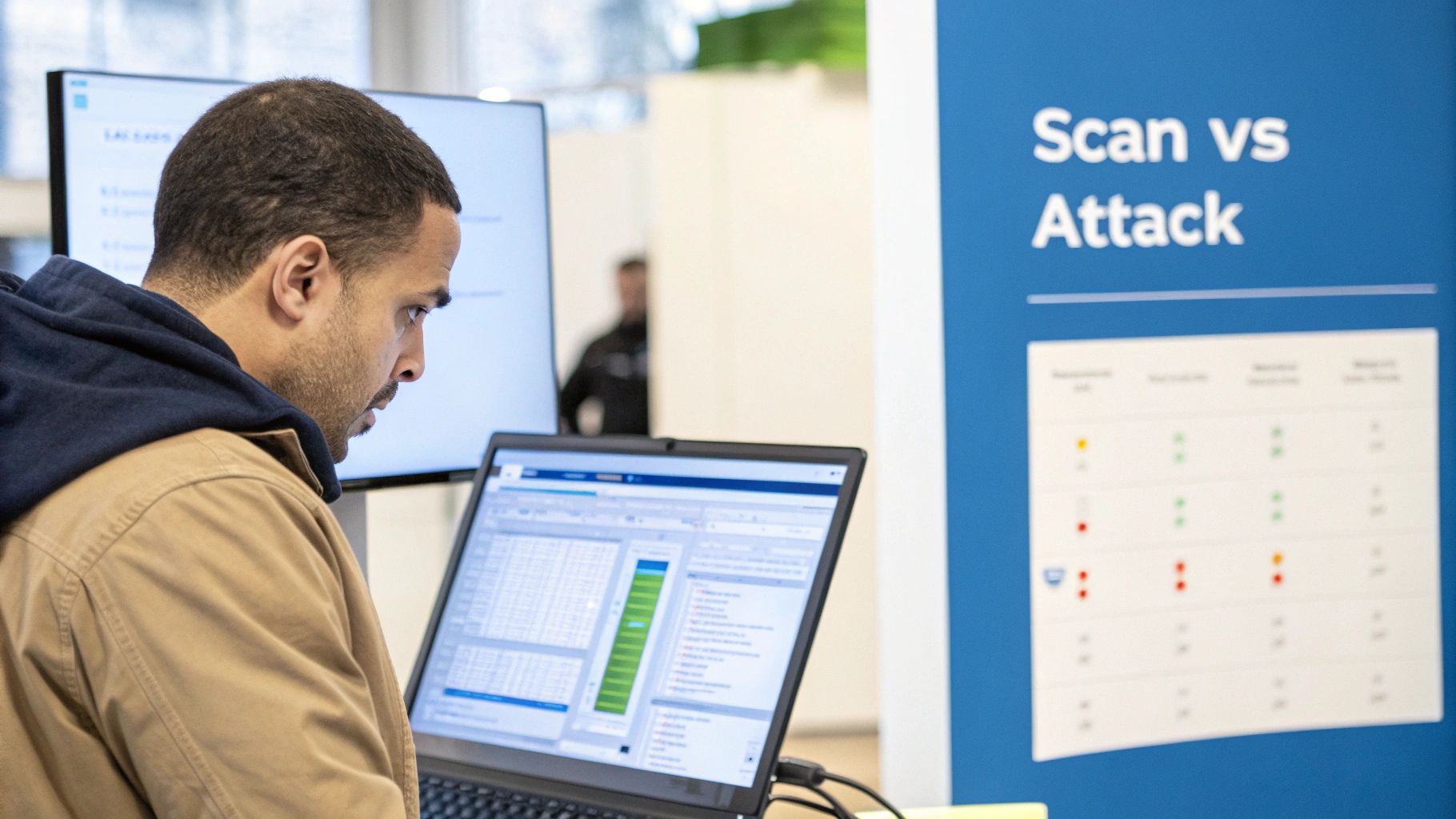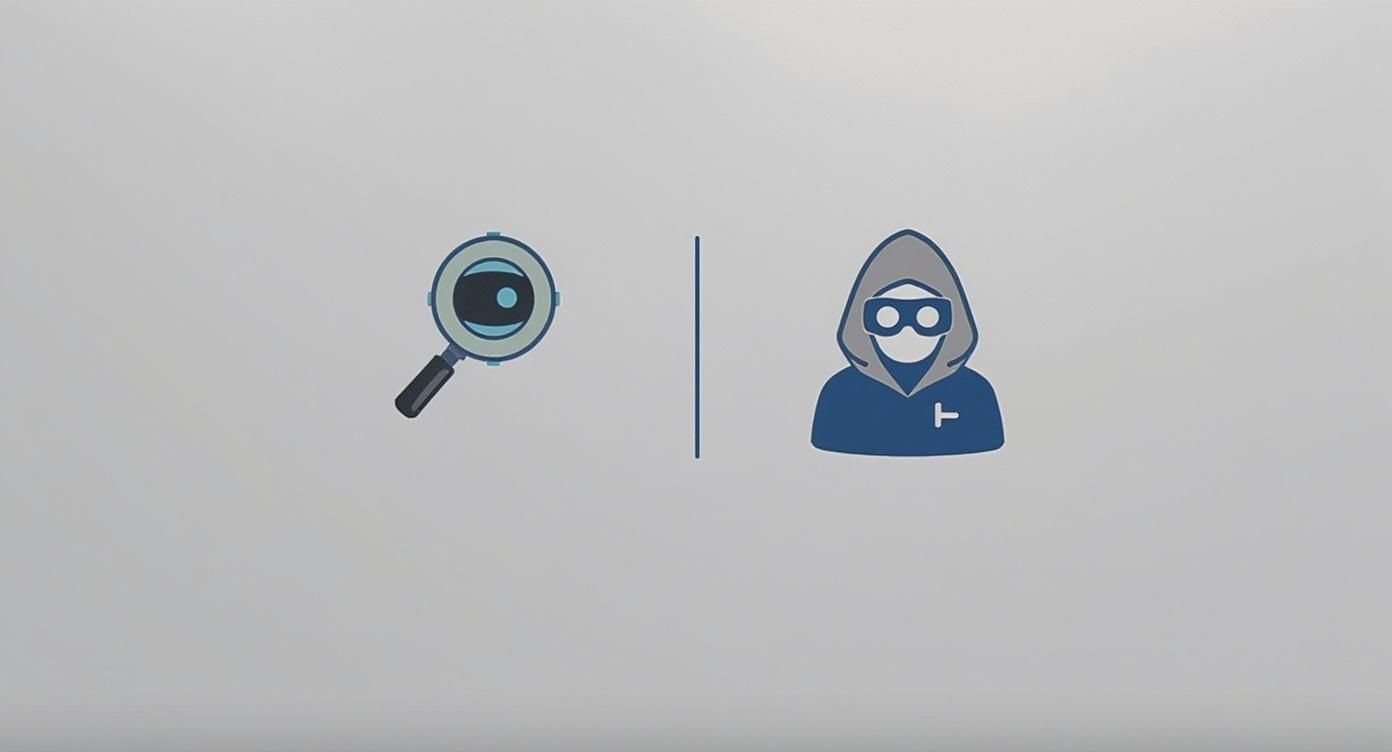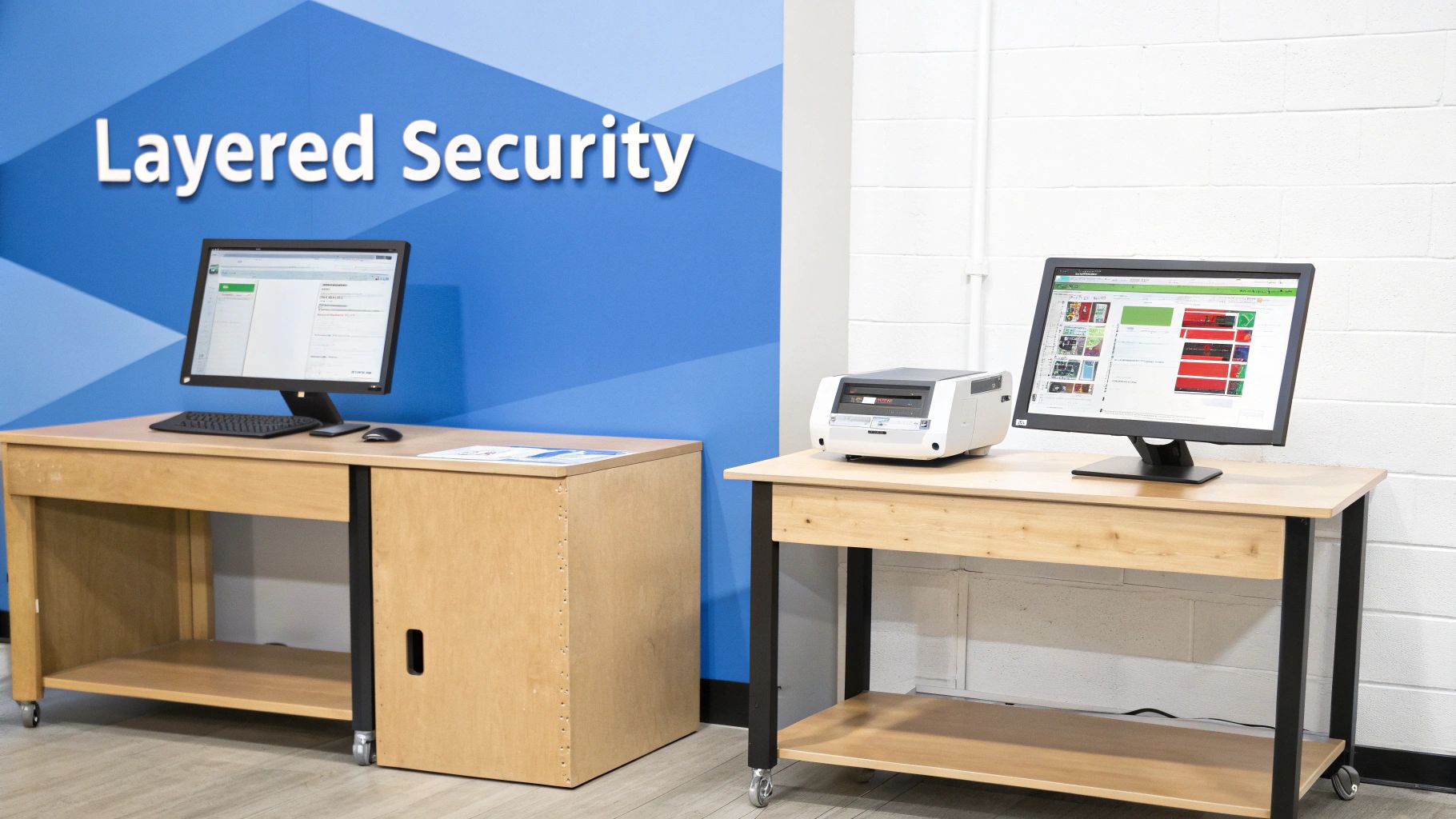A vulnerability assessment is like an automated security checklist. It scans your systems and gives you a list of things that might be weak. A penetration test, however, is a simulated cyberattack by a real person, a certified ethical hacker, to see if those weaknesses can actually be used to break in.
One finds potential problems; the other proves real damage can be done.
Understanding Penetration Testing vs. Vulnerability Assessment
If you're an MSP, vCISO, or GRC company, you know clients often mix up penetration testing and vulnerability assessment. Think of it like protecting a house. A vulnerability assessment is like a home inspector walking around with a clipboard, listing every unlocked window and weak-looking door. It’s a broad, automated scan for potential issues.

A manual pentest is like hiring a professional lockpicker to actually try and get inside. They don’t just list the weak spots; they exploit them. This shows what a real attacker could do, which is exactly the proof you need for compliance frameworks like SOC 2, HIPAA, and PCI DSS.
Our approach is built for you, the channel partner. We provide affordable, fast, and white-labeled manual pentesting. Our team holds top certifications like OSCP, CEH, and CREST, delivering the real-world results your clients need to satisfy auditors.
Here's a simple table to explain the difference:
FeatureVulnerability AssessmentPenetration TestingApproachAutomated "Find Known Weaknesses"Manual "Simulate a Real Attack"GoalCreate a broad list of potential vulnerabilitiesExploit vulnerabilities to prove riskDepthWide and shallow (finds many potential issues)Narrow and deep (focuses on exploitation)CostGenerally lower costHigher value, more intensive investmentBest ForRegular security hygiene & initial risk assessmentCompliance (SOC 2, PCI DSS) & risk validation
We are a channel-only partner. This means we provide the expert white label pentesting you need to serve your clients without ever competing with you. We work as a seamless extension of your team.
Comparing Pentesting Methodologies And Business Outcomes
The process for penetration testing and vulnerability assessment is completely different. One is an automated scan, and the other is a hands-on mission by a human expert. For your clients, this leads to very different outcomes.
A vulnerability assessment uses automated tools to check networks and applications against a huge database of known flaws. The scanner runs, flags things like unpatched software, and generates a report. Its goal is breadth—to cast a wide net and find as many potential issues as possible, fast.
The problem is the report. It's often a long, noisy list filled with false positives, which are alerts that aren't actually exploitable. This leaves you or your client to sort through the noise to find the real threats. A scanner lacks context; it can't tell if a vulnerability is truly a risk.
Our manual pentesting, on the other hand, is a mission. Our OSCP, CEH, and CREST certified experts follow the same steps a real hacker would. They use their creativity and critical thinking to find and exploit weaknesses, something a machine can't do.
The result is a clear, actionable report with verified findings—no false positives. We don't just tell you a vulnerability exists; we show you what an attacker could do with it. This is the proof needed for tough compliance frameworks like SOC 2, PCI DSS, and ISO 27001, which require realistic attack simulations. For more on the specifics, see this guide on the key differences between penetration testing and vulnerability scanning.
As your channel-only partner, we make it affordable to offer these critical services. We deliver the expert, manual testing your clients need for compliance, all under your brand.
Why A Human Expert Outperforms Automated Tools
The biggest difference between a penetration test and a vulnerability assessment comes down to the driver: an automated tool versus a creative human expert. For any MSP or vCISO, explaining this distinction is key to guiding clients correctly.
Vulnerability assessments rely on scanning software. These tools are fast and can give a wide view of potential weak spots, like a security guard with a checklist. But that’s where they stop. A scanner can’t think, understand context, or connect multiple small issues to find a major attack path.
A manual pentest is driven by an expert with an attacker's mindset. Our OSCP, CEH, and CREST certified pentesters use their skills to do what tools can't. They can chain together low-risk vulnerabilities, bypass security controls, and understand the business context to find the threats that matter most. A scanner gives you a list of potential problems; a pentest provides proof of actual, exploitable risk.
A tool might find a door, but our experts show you how they can pick the lock and access sensitive data. This is why manual pentesting is essential for any reseller whose clients need to prove their defenses work. The gap between an automated scan and a human-driven test is massive, which you can explore further by reading about automated and AI pentesting.
As a channel-only partner, we offer this expert-driven service as a white label pentesting solution, so you can deliver that value directly.
Choosing The Right Test For Client Compliance
When a client faces an audit, knowing whether they need a penetration test and a vulnerability assessment is critical. The decision almost always comes down to one thing: compliance.
A vulnerability scan rarely stands up to the scrutiny of an audit. Frameworks like SOC 2, HIPAA, PCI DSS, and ISO 27001 demand proof that security controls have been tested against a realistic, human-driven attack. A scan report bloated with potential findings just doesn't provide that assurance.
Auditors want to see a manual pentesting engagement. A scan shows where the cracks might be, but a pentest shows an auditor that you hired a professional to see if they could actually break through. For any client needing to prove their security for an audit, a manual penetration test is the definitive answer.
Auditors prefer manual pentesting because it demonstrates due diligence. Our OSCP, CEH, and CREST certified testers don't just find vulnerabilities; they exploit them to show the actual business risk.
- PCI DSS: Requirement 11.3 explicitly calls for penetration testing annually.
- SOC 2: While less specific, auditors expect to see a pentest to prove security controls are effective.
- HIPAA: The Security Rule requires a thorough risk assessment, and a pentest is a key part of that.
- ISO 27001: This framework requires organizations to treat security risks, and a pentest provides the data to do so.
This infographic shows the core difference.

The problem is, traditional penetration testing is known for being slow and expensive. This puts you, the reseller, in a tough position. Your clients need high-quality testing, but can't afford high prices or long waits. This is the exact gap we fill. As your channel-only partner, we provide fast, affordable, and expert-led white label pentesting to help you close compliance gaps and build trust.
How To Integrate Both Services For Your Clients
Knowing the difference between a penetration test and a vulnerability assessment helps you build a layered security strategy. For an MSP, vCISO, or GRC company, this creates a powerful, recurring revenue stream and makes your clients stickier. It’s about using both services together.
Think of it like a health plan. You have routine check-ups and visits to a specialist. Automated vulnerability assessments are the routine health check. These scans can run quarterly to catch common issues and keep the environment tidy.
Then, you bring in the annual manual pentesting as the deep-dive diagnostic with a specialist. Our OSCP, CEH, and CREST certified pentesters validate if defenses hold up under a real-world simulated attack. This is the crucial step that satisfies demanding compliance requirements for frameworks like SOC 2 and PCI DSS.

This layered model positions you as a strategic security advisor, not just a service provider. You’re guiding them through a complete security program. Both approaches are essential for strong network security best practices.
Our channel-only promise means we never compete with you. As a reseller, your biggest fear is a vendor selling directly to your client. That will never happen with us. We are a 100% channel-only partner. We are your silent, expert backend, providing high-quality manual pentesting as a seamless, white-label pentesting extension of your brand.
This model fixes the industry's biggest problems: inflated prices and long wait times. We deliver an affordable, fast, and expert service that lets you build new revenue streams and become a more valuable, trusted advisor.
Why Affordable Manual Pentesting Is Your Solution
The security testing industry has a problem: inflated prices, bad testing methodologies, and long lead times for penetration testing and vulnerability assessments. This forces you to choose between quality and cost. We believe you deserve both.
Our model was built to fix this. We deliver high-quality, manual pentesting that is both fast and affordable. Our value comes from our people. Our tests are run by human experts holding top certifications like OSCP, CEH, and CREST. Their creativity and critical thinking find the complex flaws that automated scanners always miss.
This focus on manual pentesting means your client reports are clean, actionable, and free of false positives. It's the difference between a long list of potential problems and a short, proven list of actual risks.
There's a myth that expert pentesting must be expensive. It doesn’t. Traditional costs are often bloated by overhead. Industry reports on penetration testing pricing show tests can range from $5,000 to over $100,000.
Our streamlined, channel-only model cuts out that bloat, and we pass those savings to you, our reseller partner. You get the same high-caliber testing at a fraction of the cost. This allows you to offer compliance-ready penetration testing to more clients, win more business, and build deeper trust.
As your silent partner, we provide the expert white label pentesting that makes you the hero. This gives you a serious competitive edge.
Common Penetration Testing And Vulnerability Assessment Questions
We get great questions from our MSP and vCISO partners about penetration testing and vulnerability assessments. Here are the most common ones we hear.
How often should my client get a penetration test?
For most compliance frameworks like SOC 2 and ISO 27001, the minimum is an annual penetration test. We also recommend a new test after any major changes to their network or applications. Combining annual pentests with regular vulnerability scans creates a strong security posture.
Is a vulnerability scan enough for a compliance audit?
Almost never. For major standards like PCI DSS, HIPAA, and SOC 2, a vulnerability scan alone is not enough. Auditors need to see proof from a manual pentesting engagement that simulates a real-world attack.
What does white label pentesting mean for my business?
White label pentesting means we do all the expert security testing, but the final report is fully branded with your company's logo. As a channel-only company, we are an invisible extension of your team. This lets you offer advanced security services and own the client relationship without the overhead of hiring an in-house team. Our affordable, fast process makes you the hero.
Ready to provide your clients with affordable, expert-led penetration testing? As your dedicated channel-only partner, we deliver fast, manual, and white-labeled security services that help you win more business.
Contact us today to learn more.


.avif)
.png)